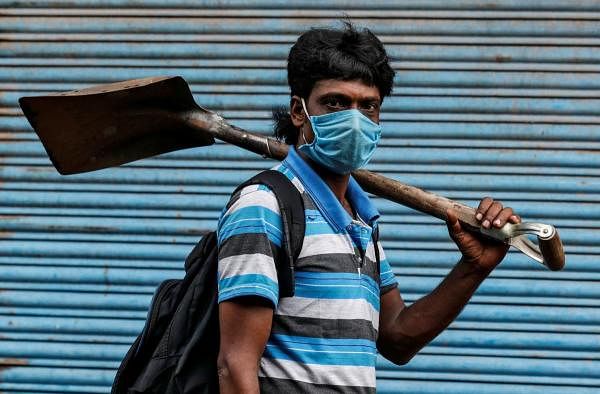
The large-scale reverse migration from the cities to the rural areas brings with it a new set of concerns for the rural economy and government policy.
The government estimates that migrant returnees number 10 million of whom about 6.7 million are spread across 116 districts in the six states of Bihar, Uttar Pradesh, Rajasthan, Madhya Pradesh, Odisha and Jharkhand.
There seems to be a fond hope that the recently launched PM Garib Kalyan Rojgar Yojana (PMGKRY, for short) will solve the short-term problem of finding immediate employment to the returnees, since it converges 25 rural-centric employment generation schemes that will provide employment for a maximum of 125 days. This, in turn, is thought will provide subsistence wages sufficient to feed the family.
The focus of the programme is to leverage the present skills of returnees and the creation of a public infrastructure in 25 listed activities including roads, panchayat bhawans, national highway works, plantation works, rural connectivity works, waste management, farm ponds, community complexes and other livelihood assets. In short, it is the continuation of the same strategy followed over the last decade or more: Public investments go into creating infrastructure, including those in public-private projects, and then expect the private sector investments to take over the baton of creating jobs.
The problem
Assuming that the government estimate of 10 million migrant returnees is accurate – and without further questioning the number of migrants or debating the definitions or the figure of 455 million people classified as migrants in the 2011 census – it is clear providing at least 10 million people with immediate employment over widely dispersed, poorly connected rural areas is a mammoth task.
The present nature of PMGKRY will leave questions about long-term employment generation potential for the economy unanswered. Remarkably, the government's Covid-19 migrant crisis response seems to borrow its essentials from the Famine Codes of 1883 to 1900, which broadly advocated transportation of grain and its distribution, construction of railways and irrigation works and providing food in return for work.
There are two ways to look at PMGKRY: Either there seems to be a fond hope it will, apart from providing short-term employment, also ignite rural consumption. Alternatively, one may be forgiven to think that by intent and design these measures are intended to be short-term in nature so that migrants will return to the urban areas and it will be business as usual once the storm passes.
If the former is the intent then, unfortunately, government measures may be too little, too late and any positive effect is likely to be short-term in nature. These policies are well-intentioned but are practical only in ‘normal’ times rather than during a crisis period. Further, the practical reality in India is that those areas close to the district headquarters tend to grow and attract most of the fund expended and this growth is invariably at the cost of the more remote regions. It is not clear if PMGKRY will solve this long-standing concern.
The return of migrants has added to the stress in labour markets at the sub-district levels where present employment is largely either through NREGS works or by way of house construction requirements. There is no doubt that some of the pressure will be eased with the onset of the agricultural season but, the relief that they may provide is as yet unknown because the farmers are reeling under price collapse due to shutting of market access and the collapse in non-agricultural production in the rural areas.
The problem with the dependence of the present-day rural economy on NREGS and house construction is that they tend to have limited shelf life, especially when there is uncertainty. In short, it means if the uncertainty continues, the government will have to keep spending scarce resources on short-term measures which may assume a quasi-permanent solution without solving the problem of employment generation – at least not as long the economy does not recover.
Try alternatives
There may be a need for a shift in government policy. The excessive focus on the private sector, especially when it is wilting under high levels of indebtedness and a collapse in demand is at best a risky strategy. Instead, there is a need for the government to consider investments not just in infrastructure but also in different kinds of economic and other social enterprises. This should be aimed at generating long-term jobs that have a long-term relevance for the economy.
This took place to some extent during the 1960s to the mid-1980s. A large number of our cities owe their economic growth engines to the large middle-class base created early due to such past investments. This is not to claim that this can be done easily, especially in an era when businesses are technology and capital intensive rather than labour intensive. These investments spread across rural areas need not be only manufacturing units rather they may be considered on the basis of expected future requirements of the country.
This public sector or quasi-public sector may help generate the much-needed jobs and with it demand while fulfilling the economic needs of the country. In retrospect and considering the past under-investments in most areas vital to our social and economic needs, any refusal of the government may seem based to be more on ideological preference rather than economic preferences.
(S Ananth is an independent researcher based in Andhra Pradesh. Views are strictly personal)
Disclaimer: The views expressed above are the author’s own. They do not necessarily reflect the views of DH.